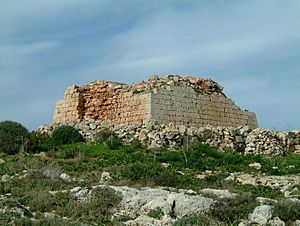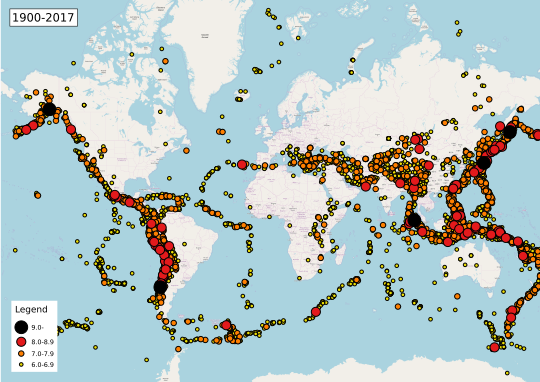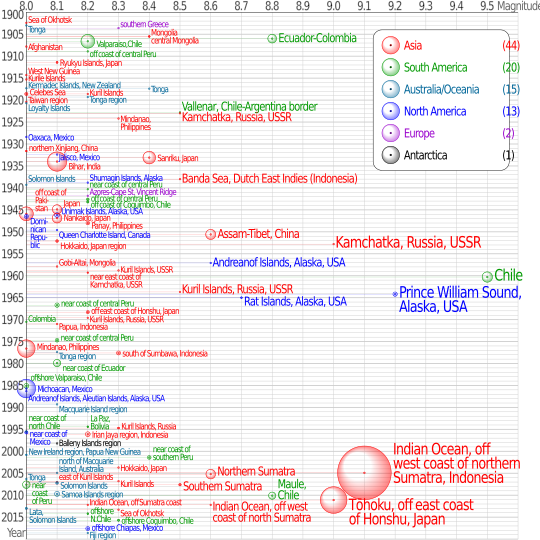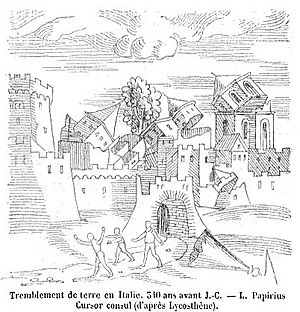Earthquake facts for kids
An earthquake is when the Earth's surface shakes. This happens because of a sudden movement deep inside the Earth's crust. Earthquakes can be very powerful and cause a lot of damage.
Earthquakes usually last only a short time, but they can happen again. They are caused by a quick release of energy in the Earth's crust. This energy creates waves called seismic waves that travel through the Earth. The study of earthquakes is called seismology. Scientists who study seismology look at how often, what kind, and how big earthquakes are.
Earthquakes can be large or small. Big earthquakes can knock down buildings and cause injuries or even deaths. We measure earthquakes using tools called seismometers. The strength of an earthquake is often reported using the Richter scale. On this scale, an earthquake of 3 or less is barely felt. But a magnitude 7 or higher earthquake can cause damage over a very large area.
If an earthquake happens under the ocean, it can create a giant wave called a tsunami. Tsunamis can cause as much damage and loss of life as the earthquake itself. Earthquakes can also cause landslides, where large amounts of rock and soil slide down a slope.
Contents
- How Earthquakes Happen
- Earthquake Sequences
- Tsunamis: Ocean's Giant Waves
- Making Buildings Earthquake-Proof
- Major Earthquakes in History
- How Earthquakes Affect People
- Managing Earthquake Risks
- How to Stay Safe During an Earthquake
- Earthquakes in Culture
- Earthquakes on Other Planets
- Related Pages
- Images for kids
- See also
How Earthquakes Happen
Earthquakes are mostly caused by the movement of huge pieces of the Earth's outer layer, called tectonic plates. Imagine the Earth's crust as a giant puzzle made of these plates. When these plates push against each other, one might slide over or under the other. This movement can build mountains, cause earthquakes, and create volcanoes.
The edges where these plates meet are called fault lines. Sometimes, these plates get stuck as they try to move past each other. When they are stuck, stress builds up. Eventually, this stress becomes too much, and the plates suddenly slip. This sudden slip releases all the stored energy, causing the ground to shake.
Types of Earthquake Faults
There are three main types of geological faults that can cause earthquakes:
- Normal faults happen where the Earth's crust is being pulled apart.
- Reverse faults (also called thrust faults) occur where the Earth's crust is being pushed together and shortened.
- Strike-slip faults are steep cracks where the two sides of the fault slide horizontally past each other. The famous San Andreas Fault in California is an example of a strike-slip fault.
Earthquake Sequences
Most earthquakes are part of a group that happens in the same area over time. Most of these groups are small tremors that don't cause much harm.
- A foreshock is a smaller earthquake that happens before a larger one. The larger earthquake is called the mainshock. Foreshocks happen in the same area as the mainshock but are always weaker.
- An aftershock is an earthquake that happens after a mainshock. Aftershocks are also in the same area as the mainshock and are smaller. They occur as the Earth's crust settles down after the big earthquake.
- Earthquake swarms are a series of earthquakes that strike in a specific area over a short time. Unlike foreshocks and aftershocks, there isn't one clearly biggest earthquake in a swarm. All the quakes in the sequence are roughly the same size. For example, there was an earthquake swarm at Yellowstone National Park in 2004.
Sometimes, earthquakes can happen in a sort of earthquake storm. This is when earthquakes hit a fault line in groups, with each one triggering the next. These storms can last for years, and some later earthquakes can be as damaging as the early ones. This happened along the North Anatolian fault in Turkey during the 20th century.
Tsunamis: Ocean's Giant Waves
A tsunami is a series of very fast-moving waves in the ocean. They are usually caused by powerful earthquakes under the sea. These waves can crash onto coastal areas, destroying houses and even wiping out entire towns.
Unfortunately, we cannot stop tsunamis from happening. However, there are warning systems that can alert people before the giant waves reach the land. This gives people enough time to get to safety.
Making Buildings Earthquake-Proof
Some places, like Japan or California, have many earthquakes and lots of people living there. In these areas, it's important to build houses and other buildings that can stand strong during an earthquake. This is called seismic design or "earthquake-proofing."
Earthquake-proof buildings are made to resist the powerful forces of an earthquake. Their strength depends on how they are built, their shape, how their weight is spread out, and how stiff they are. Different combinations of these features are used. Buildings that are square, rectangular, or shell-shaped can often handle earthquakes better than very tall skyscrapers.
To reduce stress, a building's ground floor can have very strong, hollow columns. The rest of the building can then be supported by flexible columns inside these hollow ones. Another way is to use rollers or rubber pads to separate the base of the building from the ground. This allows the building to sway safely during an earthquake.
To help prevent a roof from collapsing, builders use lightweight materials for the roof. Outer walls are made with stronger, reinforced materials like steel or reinforced concrete. Flexible windows can also help keep the glass from breaking during a quake.
Major Earthquakes in History
One of the deadliest earthquakes ever recorded was the 1556 Shaanxi earthquake in China. It happened on January 23, 1556, and killed over 830,000 people. Most homes in that area were yaodongs, which are dwellings carved into hillsides. Many people died when these homes collapsed. The 1976 Tangshan earthquake, which killed between 240,000 and 655,000 people, was the deadliest of the 20th century.
The 1960 Chilean earthquake is the largest earthquake ever measured by a seismograph. It reached a magnitude of 9.5 on May 22, 1960. The energy it released was about twice as much as the next most powerful earthquake, the 1964 Alaska earthquake (March 27, 1964). The ten largest recorded earthquakes have all been megathrust earthquakes, which happen when one tectonic plate slides under another. However, only the 2004 Indian Ocean earthquake is also one of the deadliest in history.
Earthquakes that cause the most deaths are often powerful ones that happen near cities or the ocean. Earthquakes near the ocean can create tsunamis that devastate communities thousands of kilometers away. Areas most at risk for many deaths include places where strong earthquakes are rare but powerful, and poorer regions that don't have strong building rules to protect against earthquakes.
How Earthquakes Affect People

The physical damage from an earthquake changes depending on how strong the shaking is and what kind of community is affected. Poorer and developing communities often suffer more severe and longer-lasting impacts than well-developed ones. Some effects can include:
- Injuries and loss of life.
- Damage to important services like roads, bridges, and public transport.
- Interruption of water, power, sewer, and gas services.
- Communication systems breaking down.
- Loss of vital community services such as hospitals, police, and fire departments.
- General damage to property.
- Buildings collapsing or becoming unsafe.
After an earthquake, people might face diseases, a lack of basic needs, and mental health issues like panic attacks or depression. Recovery times depend on the amount of damage and the wealth of the affected community.
Managing Earthquake Risks
Predicting Earthquakes
Earthquake prediction is a part of seismology that tries to figure out when, where, and how big future earthquakes will be. Scientists have worked hard on this, but we still cannot reliably predict earthquakes to a specific day or month.
Forecasting Earthquakes
While similar to prediction, earthquake forecasting is about guessing the general risk of earthquakes. This includes how often and how strong damaging earthquakes might be in an area over many years or decades. For faults that are well understood, scientists can estimate the chance that a part of the fault might break in the next few decades.
Earthquake warning systems have been created. These systems can tell a region that an earthquake is happening, even before the ground starts shaking where they are. This gives people time to find shelter before they feel the earthquake's impact.
Getting Ready for Earthquakes
The goal of earthquake engineering is to understand how earthquakes affect buildings and other structures. Then, engineers design these structures to reduce the risk of damage. Old buildings can be changed using seismic retrofitting to make them stronger against earthquakes. Earthquake insurance can help building owners financially if their property is damaged. Governments and organizations also use Emergency management plans to prepare for and lessen the effects of earthquakes.
Individuals can also get ready. This includes securing water heaters and heavy items that could fall and hurt someone. It's also good to know where to shut off utilities like gas and water. And, of course, everyone should learn what to do when the shaking starts. For areas near large bodies of water, getting ready for an earthquake also means preparing for a possible tsunami.
How to Stay Safe During an Earthquake
In most situations, you can protect yourself if you immediately follow these steps:
- DROP down onto your hands and knees before the earthquake knocks you down. This position protects you from falling but lets you move if needed.
- COVER your head and neck (and your whole body if you can) under a sturdy table or desk. If there's no shelter nearby, get down next to an inside wall or low furniture that won't fall on you. Cover your head and neck with your arms and hands.
- HOLD ON to your shelter (or to your head and neck) until the shaking stops. Be ready to move with your shelter if it shifts around.
- If you are in a car, pull over and stop safely. Set your parking brake.
- If you are in bed, turn face down and cover your head and neck with a pillow.
- If you are inside, stay inside until the shaking stops and you are sure it's safe to leave.
- Avoid doorways. They do not protect you from falling or flying objects. You are safer under a table.
- If you are in a tall building, do not use elevators.
- If you are outside, find an open spot away from buildings and power lines.
- If you get trapped, stay calm. Protect your mouth, nose, and eyes from dust. Call or text for help. Make noise by whistling or shouting to get attention from rescuers.
Earthquakes in Culture
Old Ideas About Earthquakes
From the time of the Greek philosopher Anaxagoras (5th century BCE) up to the 14th century CE, people often thought earthquakes were caused by "air (vapors) in the cavities of the Earth." Thales of Miletus (625–547 BCE) was one of the few who believed earthquakes were caused by tension between the earth and water. Other ideas included the Greek philosopher Anaxamines' (585–526 BCE) belief that short periods of dryness and wetness caused shaking. The Greek philosopher Democritus (460–371 BCE) generally blamed water for earthquakes. Pliny the Elder called earthquakes "underground thunderstorms."
Mythology and Religion
In Norse mythology, earthquakes were explained as the violent struggles of the god Loki. Loki, the god of mischief, was punished for murdering Baldur, the god of beauty. He was tied in a cave with a poisonous snake dripping venom on his face. Loki's wife, Sigyn, would catch the poison in a bowl. But whenever she had to empty the bowl, the poison would drip on Loki, making him jerk his head and thrash around. This caused the Earth to tremble.
In Greek mythology, Poseidon was the god who caused earthquakes. When he was angry, he would strike the ground with his trident, causing earthquakes and other disasters. He also used earthquakes to punish people and make them afraid.
In Japanese mythology, Namazu (鯰) is a giant catfish believed to cause earthquakes. Namazu lives in the mud under the Earth and is guarded by the god Kashima, who holds the fish down with a stone. When Kashima lets his guard down, Namazu thrashes about, causing violent earthquakes.
Earthquakes on Other Planets
Things similar to earthquakes have been seen on other planets, like marsquakes on Mars, and on the Moon, called moonquakes.
Related Pages
Images for kids
-
San Francisco Bay earthquake prediction
-
Damage from the San Francisco, California earthquake in 1906
-
Replica of an ancient seismometer from 133 AD. It could detect earthquakes far away.
-
The Haitian National Palace after the 2010 Haiti earthquake.
-
Earthquake epicenters mostly happen along tectonic plate boundaries, especially on the Pacific Ring of Fire.
-
Aerial photo of the San Andreas Fault in the Carrizo Plain, California.
-
Collapsed Gran Hotel building in San Salvador after the 1986 San Salvador earthquake.
-
Damaged buildings in Port-au-Prince, Haiti, January 2010.
-
Fires after the 1906 San Francisco earthquake.
-
The tsunami from the 2004 Indian Ocean earthquake.
See also
 In Spanish: Terremoto para niños
In Spanish: Terremoto para niños
















